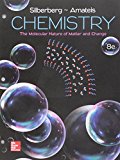
Concept explainers
(a)
Interpretation:
The partial pressure of each gas in the atmosphere is to be calculated
Concept introduction:
The ideal gas equation can be expressed as follows,
Here,
The expression to calculate the partial pressure of the gas is as follows:
Here,
The expression to calculate the mole fraction of the gas is as follows,
Here,
(a)
Answer to Problem 5.96P
The partial pressure of
Explanation of Solution
The expression to calculatethe mole fraction of nitrogen is as follows:
Substitute the value
The expression to calculatethe mole fraction of oxygen is as follows:
Substitute the value
The expression to calculatethe mole fraction of carbon dioxide is as follows:
Substitute the value
The expression tocalculatethe mole fraction of water is as follows:
Substitute the value
The partial pressure of
(b)
Interpretation:
The mole percent of each gas in the alveoli is to be calculated.
Concept introduction:
The ideal gas equation can be expressed as follows,
Here,
The expression to calculate the partial pressure of the gas is as follows:
Here,
The expression to calculate the mole fraction of the gas is as follows,
Here,
(b)
Answer to Problem 5.96P
The mole percent of
Explanation of Solution
The expression to calculate the mole fraction percent of nitrogen is as follows:
Rearrange the equation (5) to calculate the percent of
Substitute the value
The expression to calculate the mole fraction percent of oxygen as follows:
Rearrange the equation (7) to calculate the percent of
Substitute the value
The expression to calculate the mole fraction percent of carbon dioxide as follows:
Rearrange the equation (5) to calculate the percent of
Substitute the value
The expression to calculate the mole fraction percent of water as follows:
Rearrange the equation (11) to calculate
Substitute the value
The mole percent of
(c)
Interpretation:
The number of
Concept introduction:
The relationship between pressure and volume can be expressed as follows,
Here,
According to Charles's law, the volume occupied by the gas is directly proportional to the temperature at the constant pressure.
The relationship between pressure and temperature can be expressed as follows,
Here,
According to Avogadro’s law, the volume occupied by the gas is directly proportional to the mole of the gas at the constant pressure and temperature.
The relationship between volume and mole can be expressed as follows,
Here,
The ideal gas equation can be expressed as follows,
Here,
(c)
Answer to Problem 5.96P
The number of
Explanation of Solution
The formula to convert
Substitute
The pressure in
The expression to calculate the moles of the
Here,
Rearrange the equation (13) to calculate
Substitute the value
The expression to calculate the molecules of
Rearrange the equation (15) to calculate the molecules of
Substitute the value
The number of
Want to see more full solutions like this?
Chapter 5 Solutions
Package: Loose Leaf for Chemistry: The Molecular Nature of Matter and Change with Connect 2 Year Access Card
 ChemistryChemistryISBN:9781305957404Author:Steven S. Zumdahl, Susan A. Zumdahl, Donald J. DeCostePublisher:Cengage Learning
ChemistryChemistryISBN:9781305957404Author:Steven S. Zumdahl, Susan A. Zumdahl, Donald J. DeCostePublisher:Cengage Learning ChemistryChemistryISBN:9781259911156Author:Raymond Chang Dr., Jason Overby ProfessorPublisher:McGraw-Hill Education
ChemistryChemistryISBN:9781259911156Author:Raymond Chang Dr., Jason Overby ProfessorPublisher:McGraw-Hill Education Principles of Instrumental AnalysisChemistryISBN:9781305577213Author:Douglas A. Skoog, F. James Holler, Stanley R. CrouchPublisher:Cengage Learning
Principles of Instrumental AnalysisChemistryISBN:9781305577213Author:Douglas A. Skoog, F. James Holler, Stanley R. CrouchPublisher:Cengage Learning Organic ChemistryChemistryISBN:9780078021558Author:Janice Gorzynski Smith Dr.Publisher:McGraw-Hill Education
Organic ChemistryChemistryISBN:9780078021558Author:Janice Gorzynski Smith Dr.Publisher:McGraw-Hill Education Chemistry: Principles and ReactionsChemistryISBN:9781305079373Author:William L. Masterton, Cecile N. HurleyPublisher:Cengage Learning
Chemistry: Principles and ReactionsChemistryISBN:9781305079373Author:William L. Masterton, Cecile N. HurleyPublisher:Cengage Learning Elementary Principles of Chemical Processes, Bind...ChemistryISBN:9781118431221Author:Richard M. Felder, Ronald W. Rousseau, Lisa G. BullardPublisher:WILEY
Elementary Principles of Chemical Processes, Bind...ChemistryISBN:9781118431221Author:Richard M. Felder, Ronald W. Rousseau, Lisa G. BullardPublisher:WILEY





